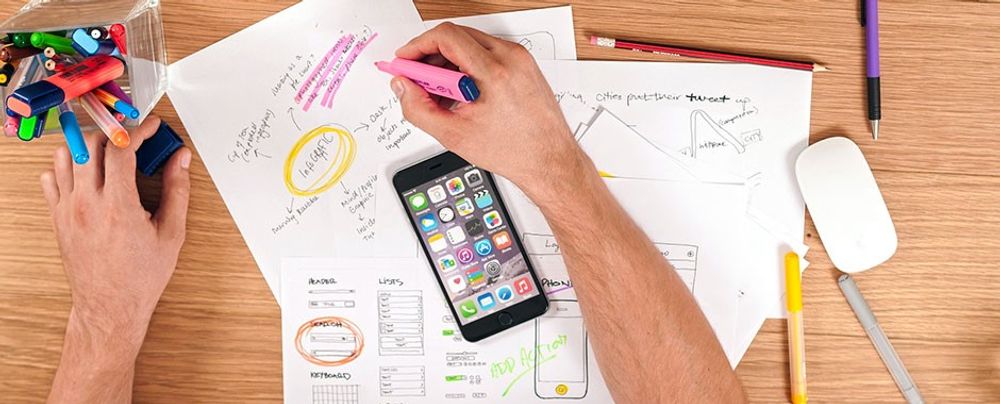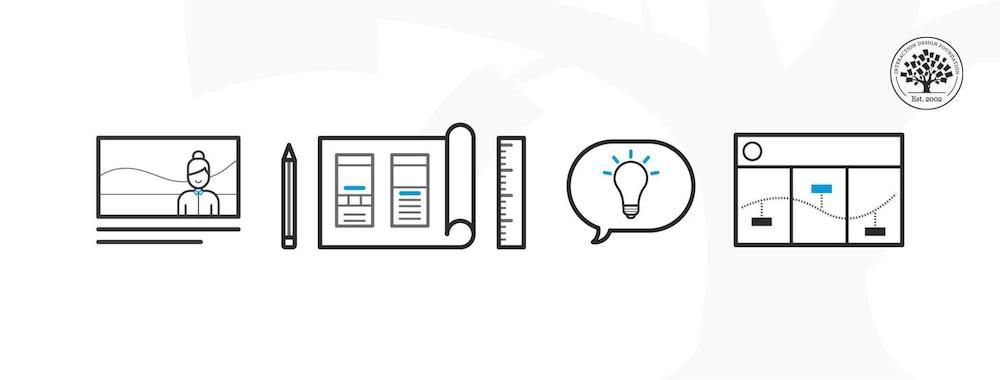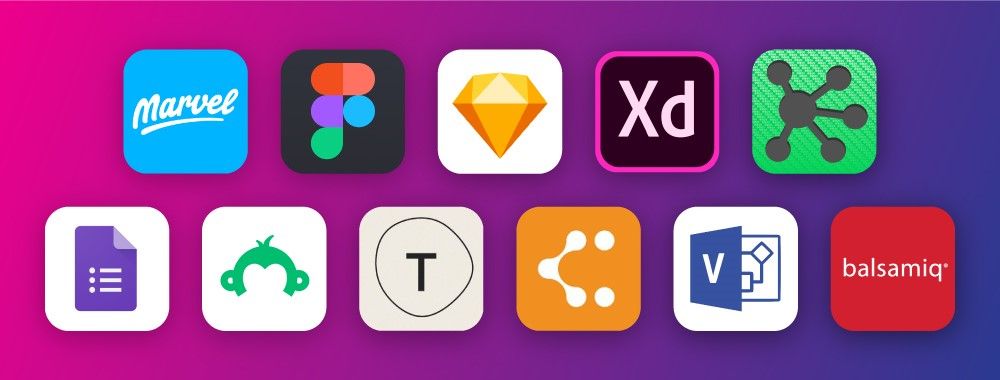6 Common Pitfalls in Prototyping and How to Avoid Them

- 979 shares
- 1 mth ago
High-fidelity prototypes are highly detailed, interactive representations of a product that closely resemble their final design. They are often created with design software and provide a realistic preview of the user experience and visual aesthetics of a product. High-fidelity prototypes are used for user testing, stakeholder approval and developer handoffs.
Explore how high-fidelity prototypes help designers in the design process, in this video with Games UX Consultant, Om Tandon.
High-fidelity prototypes bridge the gap between the design concept and the final product. Designers use this type of prototype to simulate and test a realistic user experience of the product, identify potential issues and gather feedback. This allows for a better refinement of the product before development commences. In other words, hi-fi prototypes help identify and tackle issues early, which saves costs by reducing expensive design overhauls late in the development cycle. Also, they facilitate smoother handoffs between design and development teams, which minimize misunderstandings and delays that can increase project costs.
What’s more, high-fidelity prototypes facilitate collaboration between the design team and stakeholders. They help visualize the project, keep all parties aligned and are especially useful when liaising with people with no design background. Ultimately, high-fidelity prototypes help secure stakeholder buy-in.
Fidelity refers to the level of detail and functionality of a prototype. Usually, this will depend on the product’s development stage. A prototype can give a wide view of the entire system or subsystem (called a horizontal prototype—e.g., an entire website) or it can give a detailed view of just one feature (a vertical prototype—e.g., a checkout process).
Here are the main differences:
Example: Paper prototypes.
Pros: Fast and cheap; disposable; easy to make changes and test new iterations; allow a quick overall view of the product; anyone can produce them; encourage design thinking since prototypes are visibly not finalized.
Cons: Lack of realism, so users might have a hard time giving feedback; hard to apply results from crude early versions; may be too basic to reflect the user experience of the finished product; can oversimplify complex issues; lack of interactivity deprives users of direct control.
Paper prototyping is a rapid design method involving hand-drawn sketches or printed representations of a user interface. This low-fidelity approach allows designers to quickly visualize and test design concepts without the constraints of digital tools.
© Interaction Design Foundation, CC BY-SA 4.0
Example: Digital prototypes created on software such as Figma.
Pros: Engaging—all stakeholders have the vision realized in their hands and can judge how well it matches users’ needs and solves their problems; testing will yield more accurate, more applicable results; versions closest to the final product enable you to predict how users will take to it in the marketplace.
Cons: Longer/costlier to create; users are more likely to comment on superficial details than on content; after hours of work, you the designer are likely to dislike the idea of making changes, which can take considerable time; users may mistake the prototype for the finished product and form biases.
Interactive prototypes are advanced high-fidelity mockups that enable users to interact with the design, simulating real-world usage. They offer a more immersive experience compared to static prototypes.
© Interaction Design Foundation, CC BY-SA 4.0
Some designers split high-fidelity prototyping into “mid-fidelity” (where prototypes can have basic digital interactivity or be slick wireframes) and “high-fidelity” (where they’re far closer to the final version). Interactive prototypes yield far more useful results in user tests. However, fidelity is relative—a static mockup of a landing page, for example, is of higher fidelity than sketched cut-outs users can move. Overall, the right prototype depends on the project stage and the specific product.
Take our Design Thinking course to see how prototyping works best.
Read the article Prototyping User Experience.
Read Smashing Magazine’s article A Comprehensive Guide To Wireframing And Prototyping.
A high-fidelity prototype is a realistic and interactive representation of a digital product that closely mirrors the final design in detail and functionality. It includes accurate layouts, typography, spacing, visuals, and interactivity such as clickable buttons, page transitions, and even micro-interactions. “Hi-fi” prototypes give stakeholders and users a near-final look and feel of the user interface without writing production-ready code.
Designers use high-fidelity prototypes to simulate the full user experience, making it easier to identify usability issues and gather reliable feedback. They are especially effective in stakeholder presentations and user testing because they eliminate ambiguity and showcase how users will interact with the final product.
Designers focus on consistency, visual hierarchy, and real content instead of placeholders so their hi-fi prototypes become a vital bridge between design and development, minimizing guesswork and miscommunication.
Get right into the craft of prototype-building with our article Design Thinking: Get Started with Prototyping.
High-fidelity and low-fidelity prototypes differ in detail, realism, and purpose. A high-fidelity prototype closely mimics the final product and includes polished visuals, real content, exact spacing, and interactive features.
Meanwhile, a low-fidelity prototype is a rough, simplified version, often sketched or wireframed or cut out from paper or card. It focuses more on layout and functionality ideas than on aesthetics or interactivity.
Designers use low-fidelity prototypes early in the UX design process to explore concepts quickly and cheaply—they are great for brainstorming, rapid iterations, and getting initial feedback. High-fidelity prototypes, in contrast, come later in the process to validate usability, gather more accurate user feedback, and prepare for handoff to development.
Another major difference lies in user perception—users might find a “lo-fi” prototype too sketchy or abstract if it is not made well. Meanwhile, they might not criticize a “hi-fi” prototype because of its finished appearance. Prototyping is essential in any case, and choosing between the two depends on your project phase and goals.
Explore low-fidelity prototyping in depth in our article 5 Common Low-Fidelity Prototypes and Their Best Practices.
Create a high-fidelity prototype once your basic layout, user flow, and content structure are in place and validated through low and mid-fidelity prototypes. Early design testing is vital to this stage, following ideation and user feedback cycles. It is wise to use high-fidelity prototypes to test usability in detail, simulate real interactions, or get stakeholder approval.
High-fidelity—sometimes called “high-fi” or “hi-fi”—prototyping is like a “safety net” to help designers catch design issues and align the team on what the final product should look and feel like. Avoid jumping to high-fidelity too soon; the early testing you do can save you and your team from wasting time on refining features that have not been validated or (worse) design ideas that are dead wrong. In short, the time to use hi-fi prototypes is when you are confident in the design direction and ready to fine-tune the user experience and visual details.
Discover early design testing in our course Data-Driven Design: Quantitative Research for UX.
No, you do not need coding skills to create a high-fidelity prototype. Modern tools allow designers to build highly interactive, realistic prototypes using visual interfaces. These platforms simulate interactions like clicks, scrolls, and transitions without requiring developers to write code.
Even so, an understanding of how code works can improve communication with developers and help you design more feasible interactions. Designers with a grasp of development constraints can avoid suggesting designs that are difficult or expensive to implement and instead create prototypes that are realistic enough for users and stakeholders yet flexible enough for changes without code-level complexity.
Our article "Should UX Designers Learn to Code?" helps you better understand the benefits of knowing some code as a designer.
A high-fidelity prototype should be detailed enough to mimic the final user experience without duplicating production-level code. You want it to reflect exact UI elements, spacing, typography, color schemes, and real (or close-to-real) content such as information architecture. Interactive elements such as navigation, buttons, and micro-interactions should function similarly to the final product.
That level of detail empowers teams to validate usability, get meaningful feedback, and align on expectations before development begins. Still, avoid overbuilding or over-detailing every screen; only prototype the screens and flows you need to test specific user journeys or showcase core features. Include enough fidelity so users, stakeholders, and developers understand the design intent.
Investigate information architecture (IA) closely for helpful points about how to make better prototypes and design solutions.
Include animations if they enhance understanding, improve usability, or showcase important transitions. Animations can communicate relationships between elements, give feedback, or guide user focus, functions that static screens cannot deliver as effectively.
Use micro-interactions like button feedback, form validations, or progress indicators to create a smoother experience. Animations can also help demonstrate the tone of the product and brand personality, which can influence how users perceive your interface.
However, use animations selectively, as overuse can distract users or complicate testing. Focus on interactions that add value, such as expanding menus, page transitions, or loading effects that simulate a live product. And always test animated interactions with users to ensure they support usability goals.
Understand how to bring your digital products to life and help users better, in our article The Role of Micro-interactions in Modern UX.
A high-fidelity prototype should include only the screens necessary to represent key user flows and core functionalities. Rather than design every possible screen, focus on the most important paths, typically between 5 and 15 screens, depending on the product complexity and your goals.
For usability testing, include all steps in the most common user tasks, such as sign-up, checkout, and profile edit. For stakeholder presentations, include screens that show value, visual appeal, and functionality.
Do not try to prototype every page unless the project demands exhaustive documentation. Keep the prototype navigable, consistent, and task oriented. The goal is not quantity—it is clarity and usability.
Discover additional helpful insights about testing prototypes with users, stakeholders, and more, in our article Test Your Prototypes: How to Gather Feedback and Maximize Learning.
Yes, testing your high-fidelity prototype with users is a “must,” as it reveals how people interact with your design, what they find confusing, and what they enjoy. Since high-fidelity prototypes closely resemble the final product, users respond more realistically in their behavior than they would to wireframes or sketches.
Usability testing at this stage helps you validate layout choices, content clarity, and interaction patterns before development begins, which means fewer costly revisions later. Test with a mix of real users and stakeholders to uncover both practical and strategic insights. Use specific tasks during testing, such as completing a checkout process or editing a profile. Record behaviors and ask follow-up questions to understand intent. Last, but not least, note that users may not be as critical of hi-fi prototypes (for fear of offending you), so keep a close watch on their behavior first and foremost with your prototype.
Explore how usability testing empowers designers to weed out problems and refine better designs.
For an effective design-to-development handoff, the hi-fi prototype should include all key screens, interactive flows, and clear design specifications. Use consistent styles for buttons, typography, colors, and spacing. Include hover states, active states, and error messages to show how the interface should behave in different scenarios.
Add annotations or notes where interactions, transitions, or logic are not obvious. Developers must understand not just what the user sees but how it should work behind the scenes too. Ensure you include real or finalized content instead of placeholder text.
Organize the prototype logically, and make sure it reflects the final visual direction. Label screens clearly and maintain design consistency throughout. It is important to collaborate early and often so developers get a good idea—the clearer your prototype, the smoother the implementation.
Discover further helpful information about design handoffs.
Collect feedback by conducting usability tests, running stakeholder reviews, and sharing interactive prototypes with clear instructions. Begin by observing real users completing tasks using the prototype; where do they pause, hesitate, or make errors? Ask open-ended questions to uncover their reasoning and note that users might not be as critical of high-end prototypes because they will not want to offend the designer.
Involve developers and product managers to validate feasibility and identify missing details. Share prototypes with collaborators using comments and feedback tools. Encourage asynchronous reviews, but guide reviewers by asking specific questions, such as: “Is the navigation intuitive?” or “Are the interactions clear?”
Synthesize feedback to find patterns instead of reacting to individual opinions. Look for usability issues, confusion points, and unmet user needs—you want a prototype that proves empathy with users in their context. Then, iterate quickly, being sure to prioritize changes based on impact and effort. Lastly, keep a record of feedback and how it influenced revisions.
Find additional helpful considerations, including about the vital ingredient of empathy, in our article What Kind of Prototype Should You Create?.
Designers often make mistakes like overcomplicating the prototype, ignoring usability, or skipping real content. A major pitfall is focusing too much on visuals without validating user flows or interactions; a beautiful prototype counts for little if users cannot easily complete tasks.
Another common error is creating too many screens or detailing unnecessary interactions, which can waste time and delay feedback cycles. Using placeholder text can confuse testers and skew results, so always aim for clarity with real or realistic content.
Failing to test early and often is another key mistake—high-fidelity prototypes should evolve based on feedback, not remain static. If testing has not happened before the hi-fi prototype comes about, it can be hazardous to the design.
Inconsistent spacing, unclear navigation, and poor accessibility also affect prototype and design quality. Design with users in mind, not just stakeholders. Last, but not least, collaborate with developers early to avoid surprises after handoff.
Find out how to hit the ground running with rapid prototyping and get into the habit of prototyping early in your design process.
Nielsen Norman Group. (n.d.). UX Prototyping: 5 Factors for Selecting the Right Tool [Video]. Nielsen Norman Group. Retrieved from https://www.nngroup.com/videos/prototyping-tool/
This video breaks down five critical criteria UX designers should use when choosing a prototyping tool. It emphasizes aspects like realistic interaction support, usability, collaboration features, fidelity control, and integration with workflows. For those crafting high‑fidelity prototypes, it offers a guide to pick tools that support polished visuals and user testing without excess complexity. As a trusted, research‑based source, it aids designers in avoiding tools that hamper iteration or misrepresent interactions. This clarity ensures prototypes serve testing and communication effectively without unnecessary friction.
Babich, N. (2020, March 10). From Ideas to Prototypes—Tips to Improve Your Design Process. Smashing Magazine. Retrieved from https://www.smashingmagazine.com/2020/03/ideas-prototypes-tips-design-process/
Nick Babich outlines a refined workflow guiding designers from abstract ideas through to functional prototypes. He emphasizes validating assumptions, defining MVP boundaries, and prioritizing usability before jumping into high-fidelity execution. The article helps UX professionals streamline their design iterations, avoid unnecessary detail too early, and craft prototypes that remain flexible for feedback. Designers gain practical steps to balance speed and fidelity—ensuring their high-fidelity prototypes serve clear testing goals and stakeholder communication without over-investing in visuals prematurely.
Jeliazkov, D. (2021, November 22). Why Fidelity Matters. UX Planet. Retrieved from https://uxplanet.org/why-fidelity-matters-749ac49df7d1
This article by Denislav Jeliazkov explores the strategic role of fidelity in prototyping. It examines when low-, mid-, and high-fidelity approaches make sense, and details how high-fidelity prototypes enhance the realism of usability testing and strengthen stakeholder engagement. UX designers learn the value of choosing the appropriate fidelity based on project stage and goal. The post makes designers more deliberate—helping them avoid common traps like overfidelity before validation. It supports creating prototypes that communicate intent clearly, reduce ambiguity, and yield actionable feedback aligned with real user expectations.
Remember, the more you learn about design, the more you make yourself valuable.
Improve your UX / UI Design skills and grow your career! Join IxDF now!
You earned your gift with a perfect score! Let us send it to you.
We've emailed your gift to name@email.com.
Improve your UX / UI Design skills and grow your career! Join IxDF now!
Here's the entire UX literature on High-Fidelity Prototypes by the Interaction Design Foundation, collated in one place:
Take a deep dive into High-Fidelity Prototypes with our course Build a Standout UX/UI Portfolio: Land Your Dream Job .
Master complex skills effortlessly with proven best practices and toolkits directly from the world's top design experts. Meet your expert for this course:
Morgane Peng: Designer, speaker, mentor, and writer who serves as Director and Head of Design at Societe Generale CIB.



We believe in Open Access and the democratization of knowledge. Unfortunately, world-class educational materials such as this page are normally hidden behind paywalls or in expensive textbooks.
If you want this to change, , link to us, or join us to help us democratize design knowledge!
